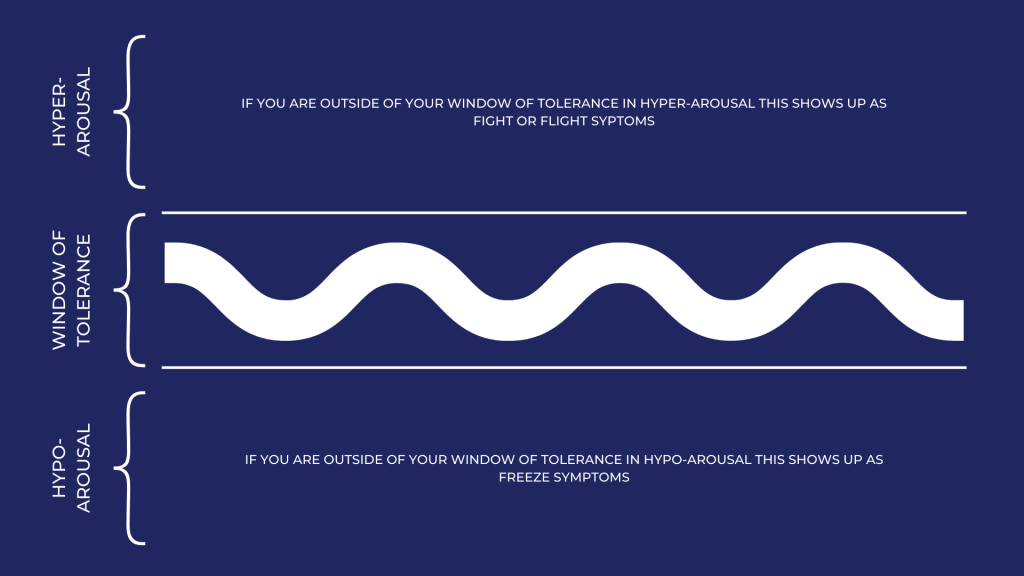Contact
bbxsafespace@gmail.com
Trauma responses are a mystery to most beyond the well-known “fight or flight”, but knowing more about them can help you a lot with supporting survivors as well as noticing these responses in yourself and others. Here is what you need to know about trauma responses (and how they show up in immediate danger, in smaller daily situations & in the long term).
The window of tolerance

The window of tolerance is a model to explain the reactions of your nervous system. In the middle of the model, we have the actual window of tolerance which is where our nervous system can handle situations and stress that fall within it. For people with trauma or other experiences impacting the nervous system this window of tolerance is much smaller and situations can easily fall outside of it.
Above the window of tolerance is hyper-arousal of the nervous system which leads to fight & flight responses. Below the window of tolerance is hypo-arousal of the nervous system which leads to freeze, dissociation and fawn responses. It is important to note that this model applies to both traumatic incidents as well as their impact on a nervous system long term. Therefore we will get into the spectrum of what each response can look like from in-the-moment survival mechanisms all the way to prolonged safety & coping mechanisms people usually develop from being outside of this window of tolerance too often. For further reading into trauma, we recommend reading “The Body Keeps The Score” by Bessel Van Der Kolk.
Fight
The most obvious response here is to physically fight the danger to survive. This can show up not only as physical fighting but also as verbal fighting. For lots of people the fight response can show up during conversations where they feel triggered by the mention of something. The urge to verbally fight is coming from this place as well. If this response is suppressed for too long people will likely develop severe anger issues or direct the anger inward which leads to depression and issues adjacent to it.
Flight
This shows up in the form of literally fleeing a situation that triggers our inner survival instinct. Flight can also show up as escapism if it is triggered and not worked through for prolonged amounts of time. Escapism that is practiced too heavily can lead to addictions and anxiety. Usually people with anxiety disorder live with their nervous system almost constantly in hyper-arousal. In day-to-day life this state can also show up as workaholic tendencies, being overly analytical and being obsessed with perfectionism.
Freeze
This one happens to a lot of people during assault or bullying. This quite literally leads to someone being unable to move out of the situation or to defend themselves. It extends to going non-verbal during a traumatic experience. Dissociation also comes from the freeze response. In daily life after trauma, this response shows up as so-called “functional freeze”. Often this functional freeze gives a person very limited energy during their day and it is often what people refer to as “functioning instead of living”. Usually this shows up in the form of brain fog, social isolation, issues with making decisions and signs of depression.
Fawn
This response is often explained as a long-term reaction to developmental or complex trauma. While that is definitely where the fawn response shows up a lot through people pleasing and co-dependency, the fawn response can also show up before (to prevent), during or after traumatic experiences. A person that is being coerced might have no choice but to fold and go with it to reduce potential harm to their physical self. An assault victim might interact with their assaulter after the assault to reduce more violence or harassment from the person in the future. This entire response is survival by fitting into the form that other people press you into. The name “fawn” refers to a baby deer for that exact reason. People that show this response for a prolonged amount of time usually have self-esteem issues, feel bad for setting boundaries and avoid conflict at all costs.
This is what you need to know about trauma responses when we boil it down to a short guide. There is obviously much more to them than these short descriptions. As always, we have to note that we are not trained psychologists. The information in this post is based greatly on the research compiled by Bessel Van Der Kolk in his book, as well as the basics of the Polyvagal Theory. We encourage you to do your own research.




